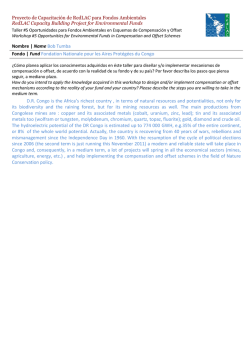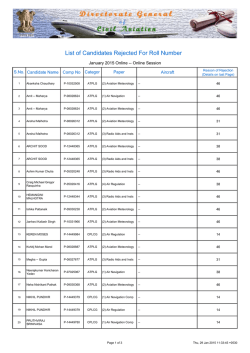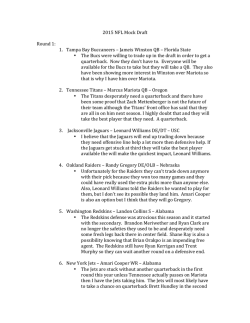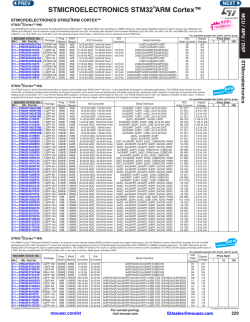
nuim.ie
Impact of Time-interleaved Analog-to-Digital Converter Mismatch on Digital Receivers Michael Soudan∗ , Ronan Farrell† Center for Telecommunications Value Chain Research Institute of Microelectronics and Wireless Systems National University of Ireland, Maynooth, Co Kildare Email: ∗ [email protected], † [email protected] Abstract— This paper presents the impact that gain, offset and timing mismatch in time-interleaved analog-to-digital converter (TIADC) have on digital receiver systems. An analysis of the mismatch errors shows the dependency of the different errors from the spectrum of the input signal. A discrete-time TIADC model is derived allowing to simulate the mismatch effects of the individual ADCs. Finally, simulations results present the performance degradation that can be expected by the usage of non-ideal analog-to-digital converters (ADC) sampling alternately the inphase and quadrature signals in a direct conversion receiver architecture when random data is processed. from the ideal sampling instant caused by clock skew and different circuit response times. This paper will present an analysis of these error mechanims and their impact on the performance of a radio receiver, methods for minimising these effects, and conclude with some guidelines for system designers on the use of time-interleaved ADCs. I. I NTRODUCTION An important figure of merit for ADCs is the signal-to-noise ratio (SNR) describing the signal power relative to the noise power in Decibel (dB), i.e. A trend in the design of digital communication systems is to minimise the analog components in favour of digital signal processing, as typified by the software-defined radio concept [1]. This requires the analog-to-digital converter (ADC) to move towards the antenna in the receiver chain, demanding ever increasing performance. Though a direct analog-to-digital conversion after the antenna would be favorable in terms of receiver flexibility, the required ADC performance is far beyond todays state-of-the-art technology. A compromise between the all-digital and the traditional processing can be achieved by using receiver architectures such as the low-IF and direct conversion architectures. However the ADC is seen as one of the most challenging components for such radio systems demanding high resolution, high sampling rates and low power consumption. The need for high ADC resolution can be demonstrated by examining the sensitivity requirements of radio, where it is necessary to detect a small communications signal in the presence of strong blocking signals and background noise. The ADC resolution has to be sufficient to convert a weak signal while the interfering signals occupy the full input range of the ADC. A common metric to assess the receiver performance is the symbol error rate (SER) of the system, specifing the ratio of wrongly detected symbols to the overall number of symbols. The second important ADC parameter is the minimum sampling rate. This is determined by the input signal bandwidth [2]. As more broadband wireless services are developed, the input signal bandwidths are increasing, for example IEEE 802.16e (WiMAX) has an option for a 25 MHz channel requiring a sampling rate in excess of 50 MSps [3]. A high resolution ADC with this sampling rate is expensive. One promising technique for providing this level of performance is through the use of multiple time-interleaved ADCs (TIADC) [4]. While time-interleaving enables the designer to improve the operall sampling system quite easily, a degradation of the spectral purity is caused by the dissimilar characteristics of the individual ADCs. In particular, gain, offset and timing mismatch between the individual ADCs causes spurious tones in the output spectrum of the TIADC thereby degrading the spurious free dynamic range (SFDR) of the system. The term timing mismatch refers to a constant deviation, as opposed to random variations, of the sampling process II. T IME -I NTERLEAVED A NALOG - TO -D IGITAL C ONVERTER snrdB = 10 log 2 1/N ∑N−1 k=0 x(n) 2 1/N ∑N−1 k=0 e(n) (1) Alternatively, the signal-to-noise can be indicated by using effective number of bits to show the effective resolution of the ADC in the presence of noise. snrenob = snrdB − 1.76dB 6.02dB/bit (2) To analyse the performance of a system using several ADCs in parallel, a mathematical model is required as shown in (3) [5], where M represents the number and m the index of the individual ADCs. The gain and offset of the ADCs is indicated by the variables ∆g and o. The error ∆t is defined as the timing error relative to the sampling period Ts which represents the sampling period of the overall timeinterleaved system. It describes deviation of the sampling process from the ideal sampling instant. Therefore, the output y(t) can be described as ∞ y(t) = M−1 ∑ ∑ ((1+∆gm )(x(t +∆tm )+om ))δ(k −kMTs −mTs ) (3) k=−∞ m=0 Normally this equation would be analysed with the assumption of a sinusoidal input, thereby allowing the derivation of the TIADC frequency spectrum (see [5]). Hoever, it is possible to simplify the calculation by estimating the effect of timing mismatch by a firstorder linear interpolation. ∞ y(t) = M−1 ∑ ∑ (1 + ∆gm )(x(t) + x(t) ∆tm ) + om δ(k −kMTs −mTs ) k=−∞ m=0 (4) The multiplication in the time domain can be represented by the convolution in the frequency domain and the TIADC spectrum becomes Y ( jΩ) = ∞ 1 ∑ MTs k=−∞ M−1 ∑ ((1 + ∆gm )(X( jΩ) + jΩ X( jΩ)∆tm ) (5) m=0 Ωs − jkm2π/M )e M Rearranging the terms of (5) shows the undesired signal parts of the individual channel spectrum, i.e. +om ) δ(Ω − k Y ( jΩ) = ∞ 1 ∑ MTs k=−∞ M−1 ∑ (X( jΩ)(1 + ∆gm + (1 + ∆gm ) jΩ∆tm ) (6) m=0 Ωs − jkm2π/M )e M Equation (6) shows that the gain and timing error terms are the replica of the input signal but with the scaling factors gm and (1 + ∆gm ) jΩ∆tm respectively. Since the timing mismatch term is multiplied with j, it can be concluded that the corresponding error signal of each channel is 90 degree out-of-phase with respect to the input signal and gain error. However, the offset term in (6) is independent of the input signal spectrum and acts as a channel dependent DC offset as had to be expected. Therefore, this error becomes a dominant part of the error specturm for weak input signals since the power of the other error spectra declines for decreasing input signals. These insights give us the opportunity to calculate the overall signal power out of the power of the dc offsets, in-phase and quadrature phase components for arbitrary input signals. This results in (7) for the mismatch power of a single channel m, i.e. +om ) δ(Ω − k Pm = om 2 + Ptm + Pgm (7) The mismatch power of the time interleaved system is given by the following equation. PT I = M−1 1 M−1 2 M−1 ( ∑ om + ∑ Ptm + ∑ Pgm ) M m=0 m=0 m=0 (8) This equation describes the mean squared error of the non-ideal signal relative to the ideal sampling instants. III. T RANSCEIVER M ODEL To simulate the impact that gain, timing and offset errors have on the TIADC spectrum, an idealised discrete-time transceiver model was derived. As a modulation scheme quadrature amplitude modulation (QAM) was selected due to its wide-spread use in current and emerging technologies. This model accounts for the transmitter side zero-padding to increase the number of samples per symbol, root raised cosine shaping of the inphase and quadrature (I/Q) pulses and the impact of white Gaussian noise on the channel. The transmitter zero-padding eases timing synchronisation on the receiver side augmenting at the same time the bandwidth requirements of the I and Q channel ADCs. The time-interleaved model comprises gain and offset factors and a fractional finite impulse response (FIR) filter for each individual ADC. Fractional delay filters are non-causal filters that allow the delaying of signals by a fraction of the sampling period. The finitelength implementation of such a filters suffers from ripples that can be attenuated by using a windowing function. However, windowing functions do not reduce the overall mismatch energy but shifts the error to higher frequencies. The causal impulse response of an even Fig. 1. QAM transceiver model. order fractional delay of length N windowed by a shifted Hann window is given by (9), where n = 0..L − 1. hFD (n) = 0.5sinc(n + D − N −1 2π )(1 − cos( (n + D))) 2 N −1 (9) IV. S IMULATION R ESULTS The model presented in section III has been simulated using 1000 uniformly distribued data points as an input signal for the quadrature amplitude modulator. The kernel lengths of the root raised cosine filters were given by 32L + 1, where L indicates the zero padding factor. The filter kernels of the utilized fractional delay filters were of the order 120 and multiplied with a shifted Hann window. The receiver TIADCs of I and Q channel comprised two ADCs each affected by a random gain, offset and timing error to account for the non-ideal ADC characteristic. These individual ADC errors were selected using a Gaussian distribution according to its given standard deviation. The full-scale range of the time-interleaved ADCs were determined by the peak-to-peak amplitude of the I respectively Q channel. The demodulated receiver output was compared with the delayed input signal of the transmitter and the mean squared error was calculated. The presented results in this section show the average value of 500 simulations to provide statistical significance. Gain and offset error values refer to the full-scale range of the ADC, whereas the timing mismatch refers to the relative deviation from the TIADCs sampling period, i.e. ∆t = tv /Ts , where tv is the absolute value of the timing mismatch. 16 bit ADCs are used in the time-interleaved system, unless stated otherwise. Fig. 2 shows the mean squared error ratio of the I/Q channel data to the periodic mismatch noise. It is interesting to notice how the impact of timing mismatch declines with increasing zeropadding factor L. This factor controls the oversampling of the signal from an ADC point of view. Therefore, the normalized bandwidth given by the ratio of signal bandwidth to sampling rate, decreases with increasing L. For a constant relative timing mismatch error ∆t, this results in a decreasing timing mismatch mean square error, as can be seen in (6). This result is consistent with the TIADC results stating that the timing mismatch power rises with increasing signal to sampling frequency ratio [5]. Gain as opposed to timing error only depends from the input spectrum but not from the sampling frequency. Therefore, increasing zeropadding only changes slightly the signal shape which has only little impact on the mismatch power. A similar dependency to Fig. 2 is shown in Fig.3, where the impact of mismatch on QAM modulation with different alphabet sizes is 16 QAM 16 QAM; L=2 110 18 100 16 14 80 snr (enob) Pc / PTI (dB) 90 70 60 50 40 −4 10 10 8 ∆ g; L=2 ∆ t; L=2 ∆ t; L=3 ∆ t; L=4 −3 12 −2 10 10 mismatch std. deviation σ ∆g ∆t o 4 ∆ g, ∆ t, o 2 −4 10 −1 10 Fig. 2. Mismatch power of a 2-channel TIADC relative to the random inphase data signal. 6 −3 −2 10 10 mismatch std. deviation σ 10 −1 Fig. 4. Signal-to-noise ratio in ENOB over the standard deviation of the mismatch errors for 16 QAM and zero- padding of 2 4 QAM & 64 QAM; L=2 110 of these errors are given as 5%, 0.5 % and 5%. The 4 QAM system is hardly affected by the mismatch of the TIADCs due to the great Euclidean distance of its constellation points. However, an increasing number of constellation points in combination with the mismatch errors increases the symbol error rate of the system, as can be seen from the 16 and 64 QAM modulation systems. 100 80 4, 16, 64 QAM; L=2 70 60 50 40 −4 10 64 QAM ∆ g; 4 QAM ∆ t; 4 QAM ∆ g; 16 QAM ∆ t; 16 QAM −3 −1 10 −2 10 10 mismatch std. deviation σ 16 QAM −1 10 ser Pc / ∆ P (dB) 90 4 QAM −2 10 Fig. 3. Mismatch power of a 2-channel TIADC relative to the random inphase data signal. −3 10 depicted. The degradation of the effective resolution of the TIADC caused by gain, timing mismatch, offset and the combination of all three mismatch types is shown in Fig. 4. The graph marked by squares depicts the combination of all three errors, where the standard of all errors is of equal magnitude. It is interesting to notice that the SNR performance for small mismatch error magnitudes exceeds the 16 bit performance of the individual ADCs. This can be explained by the low pass characteristic of the root raised cosine filter attenuating the noise in half of the Nyquist bandwidth for an oversampling of two (L = 2). This results in an SNR improvement of approximately half a bit of effective resolution. The mismatch errors degrade the ADC performance severely for mismatch values greater than 0.1 %, as can be seen from Fig. 4. Fig. 5 shows the symbol error rate of the transceiver model using 4, 16 and 64 QAM. The dashed lines indicate the symbol error performance over Eb /N0 , where the TIADC is not affected by any mismatch errors. The solid lines show the impact of gain, offset and timing mismatch error on the SER. The respective standard deviations 0 5 10 15 Eb/No (dB) 20 25 Fig. 5. Symbole error rate over Eb /N0 for 4, 16 and 64 QAM with (solid lines) and without mismatch errors (dashed lines) ([∆g, ∆t, o] = [0.05, 0.005, 0.05]) V. C ONCLUSION In this paper, we have analyzed gain, offset and timing mismatch errors in time-interleaved ADCs. We have derived formulas demonstrating the dependencies of the mismatch errors from the spectrum of the input signal. To simulate the impact, the mismatch errors have on the performance of a digital receiver, a discrete-time model has been derived. The performance degradation of a digital receiver utilizing time-interleaved ADCs has been shown for different quadrature amplitude modulation schemes and oversampling ratios. Simulations have been presented indicating that small mismatch errors deteriorate the effective resolution of the time-interleaved ADC, when root-raised-cosine shaped random data is processed. It has been shown that ADC mismatch severly increases the receiver symbol error rate for higher order quadrature modulation systems, whereas it has little impact on low order systems. ACKNOWLEDGMENTS This work has been carried out as the part of Science Foundation Ireland supported Center for Telecommunications Value Chain Research at the Institute of Microelectronics and Wireless Systems, National University of Ireland, Maynooth, Co. Kildare. R EFERENCES [1] J. Mitola, Software radios: Survey, critical evaluation and future directions, IEEE Aerospace and Electronic Systems Magazine, vol.8, pp. 25 - 36, 1993. [2] H. Nyquist, "Certain Topics in Telegraph Transmission Theory", Proceedings of the IEEE, vol.90, pp. 280-305, 2002. [3] IEEE, IEEE Std 802.16-2004, IEEE Standard for Local and Metropolitan Area Networks, Part 16: Air Interface for Fixed Broadband Wireless Access Systems, 2004. [4] W. Black, Time interleaved converter arrays, IEEE Journal on Solid-State Circuits, vol.8, pp. 1022 - 1029, 1980. [5] C. Vogel, The Impact of Combined Channel Mismatch Effects in Time-Interleaved ADCs, IEEE Transactions on Instrumentation and Measurement, vol.54, pp. 415 - 427, 2005
© Copyright 2024








